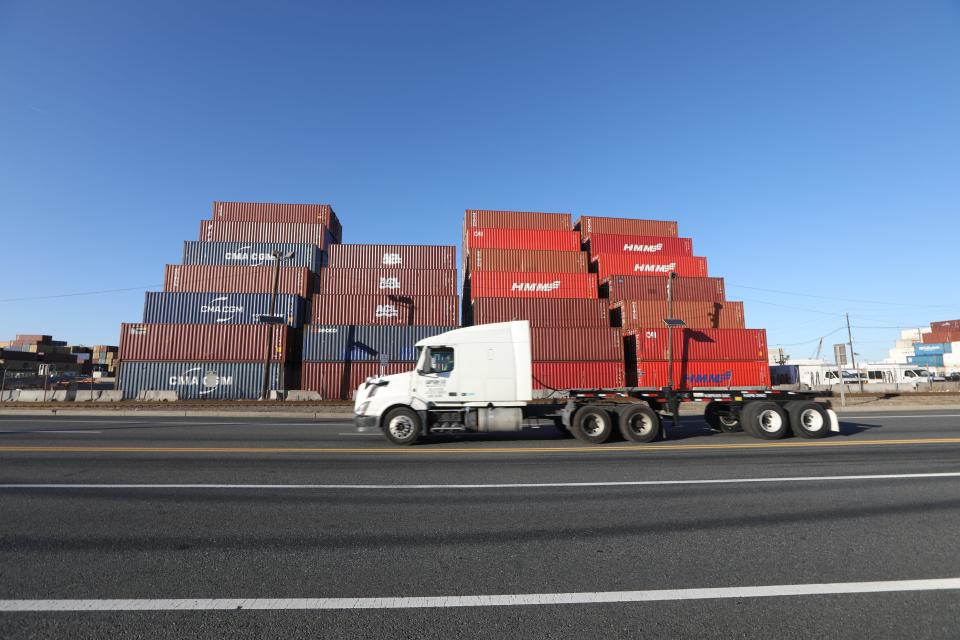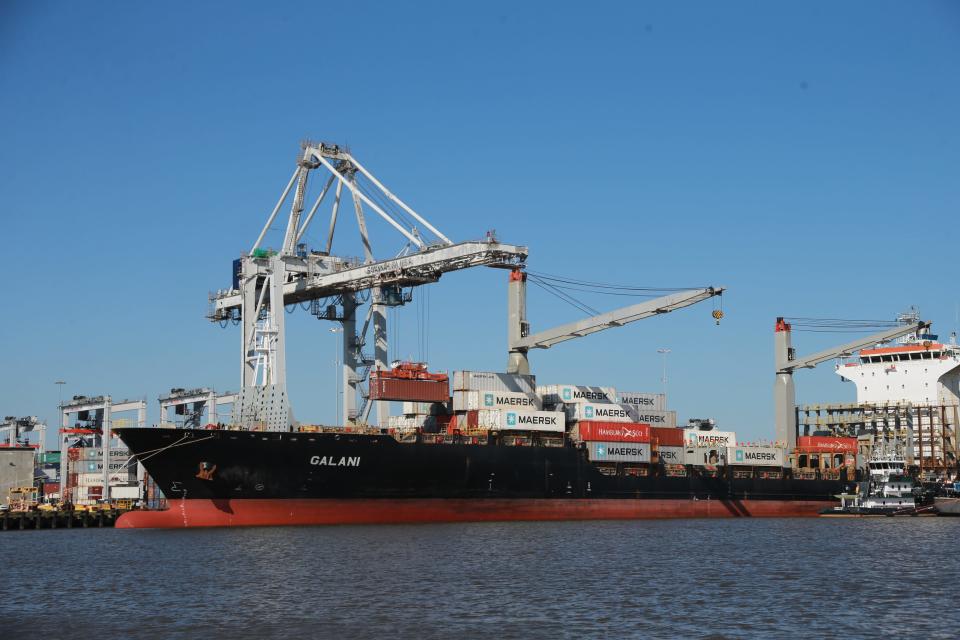The shipping industry as we know it started in Port Newark. Here's how
"SEA LAND." Big letters, on a big building, just off the New Jersey Turnpike.
Perhaps you remember, as a kid, seeing it out the car window. Perhaps you were excited. Trained seals! Dolphins doing tricks! Come on, Dad, what do you say?
As it happens, Sea-Land — unlike Florida's SeaWorld — was not a family attraction. But something exciting did happen there, says Rutgers historian Angus Kress Gillespie.
It was here at this Port Newark shipping company, now owned by Maersk — the name "Sea-Land" referred, of course, to shipping routes — that container shipping was born. And changed the world.
"We New Jerseyans can take pride in the fact that it started right here," said Gillespie, whose new book, "Port Newark and the Origins of Container Shipping," from Rutgers University Press, looks at a place, and an infrastructure, that most of us rarely think about — but that has a massive impact on our daily lives.
"This is the birthplace of containerization," he said. "It started in New Jersey."
Stacked up
Container shipping has been much in the news lately. We've all seen those pictures: hundreds of containers, stacked uselessly on wharves, to illustrate newspaper stories of "supply-side disruption." Remember those empty supermarket shelves? Those Christmas presents that didn't arrive?
It was the COVID pandemic that left trucking companies shorthanded — while at the same time fueling a vast new demand for consumer goods. "People were confined to home," Gillespie said. "Instead of going out to restaurants and malls, they were sitting at home and ordering stuff from Amazon."

But in the scheme of things, Gillespie reminds us, container shipping was a big leap forward.
The huge industry that grew up around it is visible to anyone who passes between Exits 13 and 14 of the turnpike — and gives some thought to that odd landscape of giant cranes and warehouses in the distance. Most of us don't.
"It's a paradox," Gillespie said. "It's visible, but invisible."
In fact, the adjacent sites of Port Newark and Elizabeth Port Authority Marine Terminal and nearby Port Jersey — together, the largest commercial seaport on the East Coast — make up a world unto itself.
Crane operators, forklift drivers, mooring crews, Coast Guard crews and marine carpenters all labor in this place, along with Aids to Navigation teams, tugboat hands, captains and chaplains: some 6,700 people in all. Nearly 12,000 truckers come in and out of the area. To an outsider, which Gillespie was when he began his research into the place in the early 1990s, it's overwhelming. "I was blown away, this place is so big and busy and noisy," he said.
The stories of this port and this revolutionary new kind of shipping are intertwined.
Port Newark, as a name on a map, has existed since the 1600s. But it was only after 1914, when the marshland had been dredged an extra 20 feet deep and 300 feet wide, that it became able to accommodate big ships, thus giving the ports of Brooklyn and Manhattan a run for their money.
"You could never get away with that today," Gillespie said. "The Environmental Protection Agency would shut you down."
Piecemeal
Shipping, in those days, was done "break-bulk" style. You'll remember it from movies like "On the Waterfront."
Goods were loaded, bundle by bundle, onto pallets surrounded by netting, then lifted by crane out of the hold and onto the dock — there to be loaded onto trucks and trains. It was laborious, time-consuming, inefficient.
"It took the longshoremen a lot of work to load it box by box," Gillespie said. "And not only that, but you had to have someone on ship to stow it in a particular way. It was labor intensive on the dock, labor intensive on the ship. And it exposed the goods to widespread pilferage."
It all changed on April 26, 1956, when the SS Ideal X made her way out of Port Newark on the way to Houston, carrying 58 rectangular containers. It was the first container ship — and it turned the industry upside-down.

Credit the brainstorm of one man: Malcom McLean, a trucker from North Carolina.
Why, he asked, all that inefficient loading and unloading? Why not prepack the goods into uniform, stackable metal containers that could be easily stowed on ship, and then at their destination quickly dropped onto the trailer of an 18-wheel truck — and off you go.
Sea and land transport would be combined into one operation. Hence the name of his company: Sea-Land. "Intermodal" transport, by any other name.
"I think the fact that he was a trucker made him more practical," Gillespie said. "He had no romantic love of the sea. He saw a ship as a big truck."
So much so that in his streamlined vision, all of the ships would be known by numbers, not names. He was eventually talked out of this scheme. "No captain wants to go down with a ship that's called Container Ship Number One," Gillespie said.
High seas
Gillespie does appreciate the romance of the sea.
Both his father and maternal grandfather were Navy doctors. He grew up on a series of naval bases, and as a teen attended the Leonard Hall Junior Naval Academy in Maryland.
"I became enchanted with ships and the sea," said Gillespie, an American studies professor at Rutgers whose other books include "Twin Towers: The Life of New York City's Trade Center" and — co-authored with Michael Aaron Rockland — "Looking for America on the New Jersey Turnpike."
"At 10 years old I was building ship models," he said.
His book tells the story not just of the 1950s shipping revolution, but also about day-to-day operations in a vast, essential Jersey industry — so key to our economy that the Department of Homeland Security has dubbed the area between Exits 13 and 14 on the turnpike "the most dangerous two miles in America."
"You have a seaport, you have an airport, you have oil refineries," Gillespie said. "It's full of crucial infrastructure. If an enemy was to attack the United States, this would be a prime target."
Just what does go on in that jungle of cranes, wharves and warehouses on Newark Bay? A lot.
In his book, Gillespie breaks it all down — from the work of the Seamen's Church Institute, which provides not just spiritual comfort but basic necessities to the lonely people coming in and out of port, to the buoy tenders who do what has sometimes been called "the most dangerous job in the military." It's up there, anyway.
"The buoys are at the edge of the channel, where it's shallow," Gillespie said. "If you're a ship's captain, those are the places you want to avoid. That's common sense. And what about the crane operator? He lifts the things up slowly and carefully, because if he swings it abruptly he'll kill one of the crew hands."
Homeward bound
Just to maneuver a huge freighter through the Ambrose Channel and into Newark Bay requires a whole team of specialists. A "Sandy Hook pilot" comes aboard to aid the captain about 12 miles out — only to be relieved in the neighborhood of the Verrazzano-Narrows Bridge by the "docking pilot," who, assisted by tugboats, helps get the ship docked.

"It's very tricky, with the depth and the tide and the wind," Gillespie said. "One of my Sandy Hook pilots told me the most important part of his job is getting a good night's sleep. You really have to be on the alert the next day."
All the more so in recent years, as the ships have gotten bigger and bigger — a development that has affected the entire shipping infrastructure, from the 2016 enlargement of the Panama Canal to the 2019 raising of the roadbed of the Bayonne Bridge. Today, there's talk of the whole process being automated. But whatever happens, container shipping isn't going away.
"This is something most New Jerseyans don't know about," said Gillespie, an East Brunswick resident. "There was a lot I didn't know before I dove into this topic. It was a steep learning curve."
This article originally appeared on NorthJersey.com: Port Newark NJ began shipping industry as we know it today

